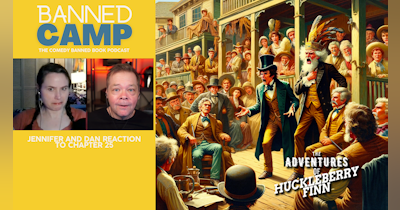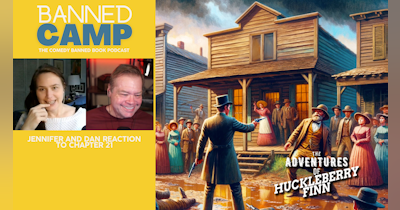Jennifer and Dan discussed Chapter 8 of "The Adventures of Huckleberry Finn" extensively in their recent episode of the uproarious Banned Camp podcast. You're in the right place if you're a fan of literature, thought-provoking discussions, and a dash of humor.
Banned Camp, known for its distinctive take on banned books, is more than just a podcast—it's a voyage into the depths of literature's controversies and complexities. In this article, we'll embark on a journey to explore Chapter 8 of Mark Twain's iconic work. But this won't be your typical analysis; we're diving deep to uncover hidden treasures seldom discussed elsewhere.
Welcome to a unique literary adventure where we unravel the threads that make "The Adventures of Huckleberry Finn" both timeless and contentious. While most articles on this chapter may skim the surface, we're here to provide you with fresh perspectives and insights that will make you see Huck and Jim's world in a whole new light.
So, whether you're a seasoned bookworm or just curious about the world of banned books, buckle up as we take you on a rollercoaster ride through Chapter 8 and beyond. Get ready to discover the nuances, characters, and themes that make this chapter, and the Banned Camp podcast, an unforgettable experience for all lovers of literature and free expression.
What Is In Chapter 8 Of "The Adventures of Huckleberry Finn"?
Before we embark on our expedition to uncover the hidden treasures of Chapter 8, why not catch up on all the Banned Camp episodes about "The Adventures of Huckleberry Finn" in their archives? It's a great way to immerse yourself in the world of Huck and Jim.
Now, let's dive into Chapter 8. In this pivotal segment of the story, we find Huck awakening on Jackson's Island, his ears perked up to the distant sound of a ferryboat firing a cannon. But this isn't just any cannon fire; it's a signal that they're searching for a drowned body—a body that Huck believes might be his. This immediate sense of peril sets the tone for the chapter.
Huck, displaying his resourcefulness, recalls an unusual way to find a body—by using a loaf of bread filled with quicksilver. It's a curious blend of superstition and practicality that captures Twain's skillful storytelling. As Huck scours the shoreline and discovers the enigmatic loaf, the question of whether prayer can truly work looms in his mind. After all, someone had prayed for the bread to find his body, and it did.
Confident in his safety, Huck begins exploring the island, only to stumble upon fresh campfire ashes. His curiosity leads him to a tree for refuge, but it's not long before it draws him back to the site. There, he encounters a significant character—Miss Watson's enslaved person, Jim. Their interaction, filled with tension and curiosity, becomes a turning point in the chapter.
As the evening unfolds, Jim's impressive knowledge of superstition adds depth to his character, making him more than just a runaway enslaved person. Chapter 8, like the rest of the book, is a rich tapestry of storytelling that combines adventure, social commentary, and the timeless question of individual freedom.
Stay tuned as we delve deeper into the themes, character development, and the intriguing symbols that make Chapter 8 of "The Adventures of Huckleberry Finn" a treasure trove worth exploring. And who knows, we might even uncover a comedic moment from the Banned Camp episode that sheds new light on this literary classic.
Character Development
In Chapter 8 of "The Adventures of Huckleberry Finn," we witness significant character development, particularly in the personas of Huck and Jim. Mark Twain's storytelling prowess shines through as he breathes life into these two unforgettable characters.
Huck, our young and resourceful protagonist, takes center stage. His thought process and actions in this chapter offer valuable insights into his character. We see Huck's quick thinking as he realizes the potential danger of the approaching ferryboat and the cannon firing, setting the stage for his resourcefulness throughout the story. Huck's unique blend of superstition and practicality, as seen in his quest for the loaf of bread filled with quicksilver, showcases his adaptability and cleverness.
However, it's Huck's moral complexity that truly comes to the forefront. As he encounters fresh campfire ashes and, eventually, Miss Watson's runaway enslaved person, Jim, Huck's internal conflict becomes palpable. Huck's initial instinct for self-preservation gives way to a genuine curiosity about Jim's situation and a growing sense of empathy.
Jim, on the other hand, emerges as a multifaceted character. Beyond being Miss Watson's enslaved person, he possesses a deep knowledge of superstition, which adds depth to his character. His superstitions reflect the complexities of life in the antebellum South, where belief systems often served as both coping mechanisms and forms of resistance.
Chapter 8 sets the stage for the evolving relationship between Huck and Jim—a central theme in the novel. It's here that we begin to see the seeds of trust and camaraderie that will define their journey as they navigate the challenges of a society marked by slavery, prejudice, and moral ambiguity.
As we continue our exploration of this chapter, keep an eye on the dynamic between Huck and Jim, for it is their evolving relationship that forms the heart of "The Adventures of Huckleberry Finn."
Themes and Symbols
In Chapter 8 of "The Adventures of Huckleberry Finn," Mark Twain weaves a tapestry of themes and symbols that add depth to the story. Let's unravel some of these layers:
1. Freedom:
- Freedom is a recurring theme in the novel, and it's palpable in this chapter. Huck, in his escape from the constraints of society, seeks freedom from his abusive father and the rules of civilization.
- Jim's escape from Miss Watson's impending sale and his quest for freedom underpin the entire narrative. His decision to run away is a courageous act in pursuit of liberty.
2. Superstition:
- Superstition plays a significant role in Chapter 8, with characters like Huck and Jim engaging in various superstitious beliefs and practices.
- Some readers and critics have argued that the portrayal of superstition might be seen as endorsing irrational beliefs or behavior, which could be a point of concern for certain groups.
3. Morality and Conscience:
- Huck's internal struggle with morality and his conscience takes center stage. His decision to return to the campsite despite initial fear highlights his burgeoning sense of responsibility and compassion.
- Twain challenges societal norms by presenting the moral dilemma faced by Huck, who begins to question the values he's been raised with.
4. Individual vs. Society:
- The tension between the individual's desires and the demands of society is evident as Huck seeks freedom on Jackson's Island. His escape signifies a rebellion against societal norms and expectations.
- Jim's escape from slavery is the ultimate expression of the individual's desire for autonomy, pitting him against the oppressive society of the time.
5. Nature:
- Nature is a constant backdrop in "The Adventures of Huckleberry Finn." In this chapter, the island itself becomes a symbol of refuge and a return to nature, away from the constraints of civilization.
- The natural world provides a sanctuary for Huck and Jim, where they can briefly escape the social injustices and prejudices of their era.
As we delve deeper into Chapter 8, keep in mind how these themes and symbols intertwine to create a rich narrative tapestry. Twain's masterful storytelling is not only entertaining but also thought-provoking, inviting readers to contemplate the complexities of human nature and society.
Chapter's Impact on the Overall Story
While Chapter 8 of "The Adventures of Huckleberry Finn" is just one piece of the larger narrative, it carries significant weight in shaping the trajectory of the story as a whole. Let's explore how this chapter leaves its mark on the overarching narrative:
1. Character Bonds:
- Chapter 8 serves as a critical juncture in the relationship between Huck and Jim. Their initial encounter in the chapter is marked by suspicion, but as they spend more time together, a bond begins to form.
- This bond becomes the emotional core of the novel, influencing their decisions and actions throughout their adventures down the Mississippi River. The chapter's impact is evident as their relationship deepens over time.
2. Themes and Motifs:
- Many of the themes and motifs introduced in Chapter 8 continue to resonate throughout the story. The theme of freedom, especially Jim's quest for it, becomes a driving force in the plot.
- Twain's use of superstition as a narrative element in this chapter foreshadows its recurring presence in the novel. Superstition becomes a lens through which the characters interpret their world.
3. Moral Development:
- Huck's moral development takes its first steps in Chapter 8. His initial instinct for self-preservation gradually gives way to a more complex moral compass.
- This evolution is pivotal in Huck's character arc, as he grapples with the moral dilemmas posed by societal norms and his growing sense of empathy for Jim and others he encounters along the way.
4. Setting the Stage:
- The events of this chapter set the stage for the larger narrative. The decision to escape to Jackson's Island is a pivotal moment, marking Huck's departure from civilization and the beginning of his adventures.
- The encounter with Jim on the island not only sets their journey in motion but also sets the tone for the exploration of themes related to race, freedom, and morality.
As we continue to explore the world of "The Adventures of Huckleberry Finn," keep in mind the enduring impact of Chapter 8. It's a chapter that lays the foundation for the complex and thought-provoking narrative that unfolds as Huck and Jim navigate the challenges of a society riddled with prejudice and injustice.
Banning Triggers: Themes from this Chapter
In the world of literature, certain themes and ideas can be viewed as contentious, and "The Adventures of Huckleberry Finn" is no exception. Chapter 8 introduces several themes that have, at times, been considered as potential reasons for banning the book. Let's take a closer look at these themes:
1. Superstition:
- Superstition is a prominent theme in the chapter, with characters like Huck and Jim engaging in various superstitious beliefs and practices.
- Some readers and critics have argued that the portrayal of superstition might be seen as endorsing irrational beliefs or behavior, which could be a point of concern for certain groups.
2. Morality and Conscience:
- Huck's internal struggle with morality and his growing sense of empathy are central to the chapter's development.
- Some might argue that this portrayal of a character questioning societal norms and acting against them could be perceived as morally subversive.
3. Individual vs. Society:
- Huck's decision to escape to Jackson's Island is a bold act of defiance against societal norms and expectations.
- Critics have contended that this theme of an individual rebelling against society might be seen as encouraging disobedience or rebellion among young readers.
4. Freedom:
- The theme of freedom, especially Jim's quest for it, is a driving force in the chapter.
- While freedom is a universally cherished value, the novel's exploration of it in the context of slavery has led to debates about its appropriateness for certain audiences.
Jennifer and Dan, in their characteristic fashion on Banned Camp, recognize these themes in Chapter 8 and acknowledge their potential to be viewed as contentious. However, they can find no reason in the chapter to ban the book based on these themes. Instead, they engage in thoughtful discussions that encourage critical thinking and a deeper understanding of the issues raised in the narrative.
As we continue to dissect "The Adventures of Huckleberry Finn" with a discerning eye, it's essential to remember that literature often challenges our preconceptions and invites us to grapple with complex themes—a process that can be both enlightening and thought-provoking.
Conclusion
In our exploration of Chapter 8 of "The Adventures of Huckleberry Finn," we've ventured into a world of themes, characters, and symbolism that captivate the imagination. This chapter, like the entire novel, is a testament to Mark Twain's storytelling genius.
As Jennifer and Dan navigate the murky waters of banned books on Banned Camp, they remind us that literature is a powerful tool for reflection, discussion, and growth. In this chapter, we've glimpsed the complex web of ideas and emotions that make "The Adventures of Huckleberry Finn" a timeless classic.
While certain themes explored in Chapter 8 may have raised eyebrows among some, Jennifer and Dan recognize that these themes serve a greater purpose—to challenge our thinking, spark conversations, and shed light on the complexities of society and human nature.
Banned Camp, a comedy podcast where we read banned books and find out why they were banned in the first place. Dive into our banned book podcast to explore more. Join us in our quest to uncover the mysteries behind banned literature and celebrate the power of storytelling in all its forms.
As we wrap up our exploration of Chapter 8 of "The Adventures of Huckleberry Finn," you might be eager to dive deeper into the world of this classic novel and the themes it presents. Here are some additional resources to satisfy your literary curiosity:
-
"The Adventures of Huckleberry Finn" by Mark Twain (Full Text): Dive into the complete text of this iconic novel to experience Huck and Jim's journey firsthand. Read it here.
-
"The Adventures of Huckleberry Finn: An Analysis and Summary" (Article): For a comprehensive analysis and summary of the entire novel, this article provides valuable insights. Read it here.
-
"Censorship and Mark Twain's Adventures of Huckleberry Finn" (Academic Paper): Explore the history of censorship surrounding this novel and its implications in this scholarly paper. Read it here.
-
"Mark Twain's Influence on Realism in American Literature" (Book): For a broader perspective on Mark Twain's impact on American literature, this book delves into his contributions and influence. Find it here.
-
"Huckleberry Finn's Impact on Modern American Literature" (Essay): This insightful essay examines how Twain's work has shaped modern American literature. Read it here.
-
"Understanding Superstition in 'Huckleberry Finn'" (Article): If you're intrigued by the theme of superstition in the novel, this article provides a deeper understanding of its significance. Read it here.
Feel free to explore these resources to enhance your appreciation of "The Adventures of Huckleberry Finn" and its place in American literature. And if you have any additional resources or specific topics you'd like to delve into further, don't hesitate to share, and we'll be happy to provide more recommendations!











